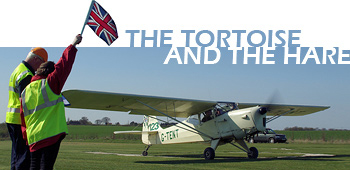
RAeC Air Race Series, Round One 2010 Report
Saturday 17th April 2010
The Royal Aero Club's 2010 Air Race series kicked off on 17 April at the picturesque airfield at Great Oakley, in the Essex countryside near Harwich. For the first of an eight venue, sixteen race series, the event was blessed with stunning clear blue skies, lacking even in contrails thanks to the ash-induced NATS airspace restrictions. The competitors arrived in an assortment of dissimilar light aircraft, with clearly disparate performance envelopes.
reports for UK Airshow Review.
Great Oakley is quite a young airfield, having been set up as a farm strip for the owner's aircraft as recently as 1992. It has since expanded to include three hangars and includes a small unit carrying out long term restorations on two Percival Proctors. This was also the airfield's first hosting of the air race. Titled the 'Tendring Air Race' and taking in a number of local coastal towns as turning points, much of the 30 mile course would be over water. With the key to success in the race format being accurate navigation, it would be an interesting test for the competitors.
The air race is run on a handicapping system. Each entrant has a theoretical race completion time, based on the aircraft's maximum straight line speed. Working backwards from the ideal situation of all the aircraft crossing the finish line at the same time, a start time for each is calculated. As mentioned, the skill of the crew in navigating each circuit in the shortest distance, from each turning point to the next, is the means to gain time. Seeing the theory being put into practice on the day was highly impressive, with three aircraft waiting on the runway, and three on the immediate hold to enter at any one time. Some of the time separations were very long, with others very short calling for some 'expediting'.
As the faster aircraft were taking their positions at the start, the slower machines were already making their way around the early laps. Even with all the entrants in the air, it was difficult to figure out how the race was proceeding. It wasn't until the final lap that the small dots and distant flashes of top surfaces around the corners indicated that the handicapping system was indeed coming into effect. So there they came, galloping towards the finishing line at all sorts of altitudes. Before any results could be announced, each aircraft's GPS unit had to be checked to ensure against corner cutting. In the final analysis the slowest aircraft in the entry list therefore effectively led from start to finish on both of the weekends races. Rob Calloway-Lewis in his Auster J1N G-TENT (Race 123) secured Saturday's SBAC Trophy, and Sunday's Strongbow Trophy. A victory for the tortoise!






























